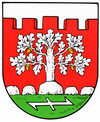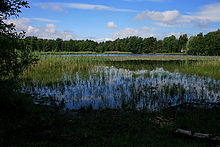Kleinburgwedel
|
Kleinburgwedel
City of Burgwedel
|
||
|---|---|---|
| Coordinates: 52 ° 30 ′ 33 " N , 9 ° 52 ′ 42" E | ||
| Height : | 56 m above sea level NHN | |
| Area : | 17.91 km² | |
| Residents : | 2594 (Jan. 1, 2007) | |
| Population density : | 145 inhabitants / km² | |
| Incorporation : | March 1, 1974 | |
| Postal code : | 30938 | |
| Area code : | 05139 | |
|
Location of Kleinburgwedel in Lower Saxony |
||
|
House of the church in Kleinburgwedel
|
||
Kleinburgwedel ( Low German Littjen Borwee ) is a village and northeastern part of the city of Burgwedel in the Hanover region in Lower Saxony .
history
In the Middle Ages, Kleinburgwedel formed the parish of Burgwedel together with Großburgwedel , Oldhorst , Neuwarmbüchen and Fuhrberg . Regardless of the many war costs, Duke Wilhelm found funds to buy goods. On January 6, 1361, he and Duke Ludwig von Aschwin von Alten acquired many farms and cottages in Kleinburgwedel, Thönse , Wettmar , Engensen , Schillerslage , Burgdorf , Sorgensen , Weferlingsen and Aligse with all their accessories, except those pieces that Aschwin von Alten had lent and reserved when selling. Aschwin had only owned the goods at Kleinburgwedel from Duke Wilhelm zu Lehn; of the rest, he vowed to grant him and Duke Ludwig the fief.
The church registers are preserved from 1661. They show an average population growth of 1.5%, which only declined slightly around 1830.
Due to its location on the southern edge of the Lüneburg Heath , bees are kept in Kleinburgwedel to this day. Between 1589 and 1900, between 70 and 150 standing peoples were regularly placed in straw baskets. The number of bee colonies has fluctuated strongly since the middle of the 20th century.
On August 28, 1808, a major fire disaster occurred in Kleinburgwedel. Eleven houses and 16 outbuildings burned down in a single night.
The Second World War initially did not affect Kleinburgwedel. At the beginning of the war, a flak spotlight position was set up near the station. In the immediate vicinity there was a small barrack camp for Soviet prisoners of war . The actual war events reached the village when British bomber units launched major raids on Hanover in October 1943. On October 9, a British Halifax crashed into the meadows west of Kleinburgwedel after being hit by flak. On October 18, a large bomber association threw incendiary bombs on the village due to poor visibility, which were actually intended for Hanover. 40 buildings burned down; a large number of others were severely damaged.
On March 1, 1974, Kleinburgwedel was incorporated into the new municipality of Burgwedel.
politics
Local council
The local council of Kleinburgwedel consists of two councilors and three councilors.
(Status: local election September 11, 2016)
Local mayor
The local mayor is Jürgen Schodder (CDU). His deputy is Friedhelm Leisenberg (CDU).
coat of arms
The draft emblem of small Burgwedel comes from the in Isernhagen born and later in Hannover living heraldry and crest painter peoples Gustav , who has the coat of arms of Großburgwedel , Melle village , Wunstorf has designed and many other towns. The approval of the coat of arms was granted by the district president in Lüneburg on December 9, 1959.
| Blazon : “In silver in front of a high, five-pinned , red wall, a stylized, silver oak , growing out of the middle of five stones . In the green base of the shield there is a silver wolf tang . " | |
| Justification of the coat of arms: The red wall reminds us that there used to be a castle in Kleinburgwedel, which was destroyed in the Hildesheim collegiate feud in 1521 . The remains of the ramparts with thirteen large boulders and strong oaks have been preserved until 1870. Therefore the stones and the oak tree were included in the coat of arms. The Wolfsangel symbolizes belonging to the Burgdorf district , which also has this symbol in its coat of arms. |
Culture and sights
Green spaces and recreation
- The Würmsee, which was gradually silting up and largely dried out in 2014, is located in the district. A larger area was covered with water again at the beginning of 2016. It was probably created from a peat cut in the 19th century and reached an area of the order of ten hectares. The Hanoverians already used it as a destination during the German Empire. Townspeople built a few weekend huts on its banks, which were used after 1945 to accommodate refugees and expanded into a larger settlement. The boat rental stopped a few years ago.
- The botanical peculiarities of the 171 hectare Trunnenmoor nature reserve include gagel , lung gentian and peat moss orchid , which has recently disappeared. Numerous shallow ponds were created from peat cuttings . There are 26 known dragonfly species in the local fauna, several of which are on the Lower Saxony Red List .
Architectural monuments
Economy and Infrastructure
Public facilities
In Kleinburgwedel there is a day-care center and a primary school, which also has a children's library. Opposite it is the house of the church of the St. Petri community in a typical landscape hall house ("Lower Saxony house") with a concise wooden bell tower.
The Kleinburgwedel volunteer fire brigade provides fire protection and general help, especially at the local level.
traffic
Kleinburgwedel is served by the RegioBus Hanover bus routes within the Hanover region's local traffic . The place is located within the tariff area of the Greater Hannover GVH traffic . Regional buses stopping in Kleinburgwedel go to Großburgwedel , Engensen and Fuhrberg . (As of December 2015) The Großburgwedel stop on the Hanover – Celle railway line that runs through Kleinburgwedel is about one to two kilometers away, and the Großburgwedel junction of the federal motorway 7 is about five to six kilometers away.
Personalities
- Uwe Kemmling (* 1960), former German soccer referee
literature
- Kurt Griemsmann: Picture chronicle Alt-Burgwedel: Großburgwedel, Kleinburgwedel, Thönse, Wettmar, Engensen, Fuhrberg, Oldhorst in words and pictures . Burgwedel 1975
- Christian Heppner: Burgwedel - The history of the seven villages Engensen, Fuhrberg, Großburgwedel, Kleinburgwedel, Oldhorst, Thönse, Wettmar . Hanover 1999 (Editor: Municipality of Burgwedel)
- Kleinburgwedel 1310–2010: 700 years of eventful history . Kleinburgwedel 2010
Web links
Individual evidence
- ↑ a b Figures, data, facts. In: Website of the city of Burgwedel. January 1, 2007, accessed October 6, 2017 .
- ^ Sudendorf, Hans: Document book for the history of the dukes of Braunschweig and Lüneburg, Volume 3, Hanover 1862, S. LXXXII.
- ↑ In detail: Matthias Blazek: Das Löschwesen in the area of the former Principality of Lüneburg from the beginnings to 1900. Adelheidsdorf 2006, p. 177, ISBN 978-3-00-019837-3 .
- ^ Federal Statistical Office (ed.): Historical municipality directory for the Federal Republic of Germany. Name, border and key number changes in municipalities, counties and administrative districts from May 27, 1970 to December 31, 1982 . W. Kohlhammer GmbH, Stuttgart / Mainz 1983, ISBN 3-17-003263-1 , p. 221 .
- ↑ a b Local council Kleinburgwedel . On: Website of the city of Burgwedel, accessed on July 15, 2017
- ↑ District of Hanover: Wappenbuch district of Hanover. Published by the author himself, Hanover 1985
- ↑ Where is the water in the Würmsee? In: HAZ. December 2014, accessed May 9, 2014 .
- ↑ Marktspiegel Verlag GmbH: 2016: A new attempt to save the Würmsee? In: marktspiegel-verlag.de. Retrieved March 28, 2016 .




